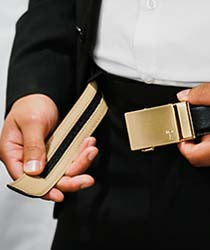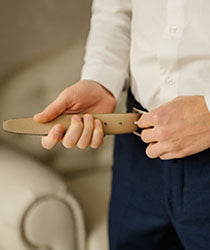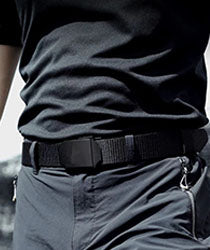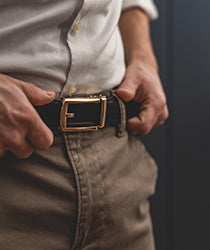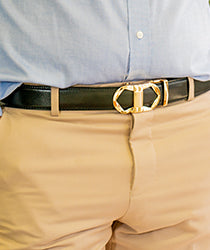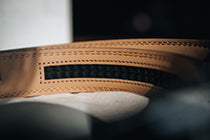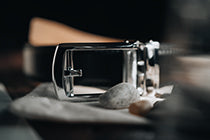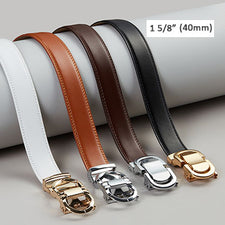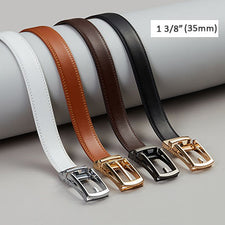Belts are not just functional accessories that hold your pants up; they are also essential fashion pieces that can make or break your outfit. However, many men unknowingly make common belt mistakes that can undermine their style and overall appearance. In this article, we will explore the worst men's belt mistakes and provide you with valuable tips to avoid them. From choosing the right size and quality to considering style, buckle details, and proper placement, we will cover everything you need to know to rock the perfect belt. So, let's dive in and ensure you never make these belt blunders again!
Wearing the Wrong Size
Understanding belt sizing
One of the most common belt mistakes men make is wearing the wrong size. Belt sizing can be confusing for many, but understanding the basics can help you avoid this error. Belt sizes usually correspond to the length from the buckle to the middle hole, excluding the buckle itself.
How to measure your waist size
To determine your belt size, measure your waist circumference with a tape measure. Make sure to measure around the area where you usually wear your belt. Once you have your waist measurement, you can use it to find the appropriate belt size.
Avoiding belts that are too long or too short
Wearing a belt that is too long or too short can ruin your overall look. Belts that are too long will create an unsightly tail, while belts that are too short will leave you struggling to fasten them properly. Always choose a belt size that leaves you with enough room to comfortably fasten it while avoiding excessive excess.
Neglecting Belt Quality
Importance of durable materials
Investing in a high-quality belt is essential. A well-made belt not only lasts longer but also retains its shape and appearance over time. Cheaply made belts are prone to cracking, stretching, and fraying, compromising both their functionality and style.
Choosing genuine leather belts
When it comes to belt materials, genuine leather is a top choice. Leather belts are not only stylish but also durable and versatile. Look for belts made from full-grain or top-grain leather for the best quality and longevity.
Avoiding cheaply made belts
While the price tag may be tempting, it's best to steer clear of cheaply made belts. These belts often use inferior materials and construction methods, leading to premature wear and tear. Instead, invest in a quality belt that will elevate your outfit and last for years.
Ignoring Belt Style and Occasion
Matching belts with outfits
Your belt should complement your outfit and tie the whole look together. Neglecting to consider the style and occasion can lead to mismatched ensembles. For formal occasions, opt for classic leather belts with simple and understated buckles. For casual outfits, you can experiment with different materials, colors, and patterns.
Formal vs. casual belts
Understanding the difference between formal and casual belts is crucial. Formal belts are typically narrower, plain, and made from leather. On the other hand, casual belts can be wider, embellished, and made from various materials like canvas, suede, or fabric.
Choosing the right color and finish
The color and finish of your belt should harmonize with your overall attire. Black and brown are timeless choices that go well with most outfits. Consider the occasion and color scheme when selecting a belt color. Additionally, the finish of the belt buckle should match other metal accessories you are wearing, such as watches or cufflinks.
Overlooking Belt Buckle Details
Appropriate buckle size
The size of your belt buckle should be proportional to your body and the width of the belt. Oversized buckles can draw unwanted attention and overwhelm your outfit, while tiny buckles may appear insignificant. Choose a buckle size that complements your physique and the belt's width.
Selecting the right buckle style
Belt buckles come in various styles, from classic pin buckles to modern ratchet buckles. Consider your personal style and the occasion when selecting a buckle. Pin buckles are more formal, while ratchet or sliding buckles offer convenience and adjustability.
Avoiding oversized or flashy buckles
Flashy and oversized belt buckles can make your outfit look tacky and outdated. Unless you're attending a Western-themed event, it's best to avoid excessive embellishments and opt for clean and sleek buckle designs.
Improper Belt Placement
Wearing the belt too high or too low
Proper belt placement is crucial for a polished look. Wearing your belt too high or too low can throw off your proportions and make your outfit appear off-balance. The belt should sit comfortably on your waistline, just above the hips.
Positioning the belt buckle
The belt buckle should be centered and aligned with the pants' button or zipper. Misaligned buckles can create a sloppy appearance. Take a moment to adjust the buckle's position and ensure it sits straight and symmetrical.
Ensuring proper belt tension
The belt should be fastened snugly, allowing for a comfortable fit. Avoid tightening the belt excessively, as it can create unsightly bulges or discomfort. On the other hand, a belt that is too loose can look sloppy and undermine its purpose.
Disregarding Belt Condition and Maintenance
Regular belt inspections
Regularly inspect your belts for signs of wear and tear. Look for cracks, frayed edges, or stretched holes. Replace any belts that show significant damage or signs of deterioration.
Cleaning and conditioning leather belts
Leather belts require proper care to maintain their appearance and extend their lifespan. Clean your leather belts regularly with a soft cloth or brush. Apply a leather conditioner to keep the leather supple and prevent it from drying out.
Replacing worn-out belts
No matter how well-maintained a belt is, it will eventually wear out. Pay attention to signs of wear such as excessive stretching, visible damage, or a deteriorating appearance. When a belt reaches this stage, it's time to replace it with a new one.
Inappropriate Belt Pairings
Avoiding mismatched belt and shoe colors
Your belt and shoes should ideally match in color and style. Black belts pair well with black shoes, while brown belts match with brown shoes. Avoid wearing a black belt with brown shoes or vice versa, as it creates a noticeable mismatch.
Coordinating belt with other accessories
Consider coordinating your belt with other accessories such as watches, bracelets, or rings. This adds a cohesive and put-together touch to your overall look. Choose accessories that share similar metal finishes, such as silver or gold, to maintain a consistent style.
Belt compatibility with pant style
Different pant styles call for different belt choices. Slim-fit pants pair well with narrower belts, while wider belts work better with jeans or trousers with wider belt loops. Consider the pant style when selecting the appropriate belt width.
Choosing the Wrong Belt for the Body Type
Belts for different body shapes
Different body shapes require different belt styles to create a flattering silhouette. If you have a larger waist, opt for wider belts to balance your proportions. Slimmer individuals can choose narrower belts to maintain a sleek look.
Belt width and body proportions
The width of your belt should be proportional to your body frame. For example, if you have a broader build, a thin belt may get lost and appear insignificant. Conversely, a wide belt on a slender frame can create an unbalanced and disproportionate look.
Creating balance with the right belt
The right belt can help create balance and enhance your body shape. Experiment with different belt widths and styles to find the ones that best flatter your physique. A well-fitted belt can draw attention to your waistline and create a more defined silhouette.
Neglecting Personal Style and Comfort
Finding a belt that complements your style
Your belt should reflect your personal style and complement the overall aesthetic you want to achieve. Whether you prefer a classic, minimalist look or a bold and trendy style, choose a belt that aligns with your fashion preferences.
Considering comfort and functionality
While style is important, don't forget about comfort and functionality. A belt that pinches, digs into your waist, or constantly needs readjusting can be a major annoyance. Look for belts with high-quality buckles, adjustable sizing options, and comfortable materials.
Trying different belt designs and fits
Don't be afraid to experiment with different belt designs, fits, and materials. Trying out new styles can help you discover unique looks that suit your personality and enhance your outfits. Step out of your comfort zone and explore belts with interesting textures, patterns, or unconventional materials.
Not Keeping Up with Belt Trends
Staying updated with fashion trends
Fashion trends evolve over time, and belts are no exception. Staying up to date with the latest belt trends can elevate your style and keep your outfits fresh and modern. Follow fashion blogs, magazines, or social media accounts for inspiration and insights into the latest belt designs.
Modern belt designs and materials
Contemporary belt designs often feature innovative materials, unique textures, and unconventional buckle styles. Explore belts made from woven fabrics, distressed leather, or even alternative materials like metal or wood. These modern options can add a distinctive flair to your outfits.
Avoiding outdated belt styles
Certain belt styles can quickly become outdated and give your outfit a dated appearance. Stay away from belts with excessively wide or excessively narrow widths that were popular in previous decades. Opt for classic designs that have stood the test of time and continue to be fashionable.
Conclusion
Choosing the right belt and avoiding common mistakes is essential for a well-put-together and stylish look. By understanding belt sizing, considering quality and style, paying attention to buckle details and placement, maintaining belts properly, and aligning them with your body type, personal style, and the occasion, you can avoid the worst men's belt mistakes.
Remember to keep up with fashion trends and try different belt designs to discover your own unique style. With the right belt choices, you can enhance your outfits, elevate your fashion sense, and exude confidence in every occasion.
FAQs
Q1: Can I wear a casual belt with a suit?
A: It is generally recommended to wear a formal belt with a suit. Formal belts are typically narrower and made from leather, while casual belts are often wider and made from more relaxed materials like canvas or fabric. Opt for a classic leather belt with a simple buckle for a polished look with a suit.
Q2: How often should I replace my belt?
A: The lifespan of a belt depends on its quality, frequency of use, and how well it is maintained. However, as a general guideline, it's a good idea to inspect your belt regularly for signs of wear and tear. If you notice cracks, fraying, stretching, or other significant damage, it's time to replace it with a new belt.
Q3: Are fabric belts suitable for formal occasions?
A: Fabric belts are generally considered more casual and are better suited for relaxed or informal occasions. For formal events or professional settings, it's best to choose a classic leather belt that complements your outfit and looks more polished and refined.
Q4: Can I wear a belt that's slightly longer?
A: It's generally advisable to choose a belt that fits you properly and isn't excessively long. A belt that is too long can create an unsightly tail that disrupts the overall look of your outfit. However, a belt that is slightly longer can still be worn as long as it doesn't look overly disproportionate or affect its functionality.
Q5: Are reversible belts a good option?
A: Reversible belts can offer versatility by providing two different colors or finishes in one belt. They can be a practical choice for certain occasions or outfits. However, keep in mind that reversible belts often have a thinner construction, which may affect their durability and longevity compared to regular belts. Consider your needs and preferences before choosing a reversible belt.

